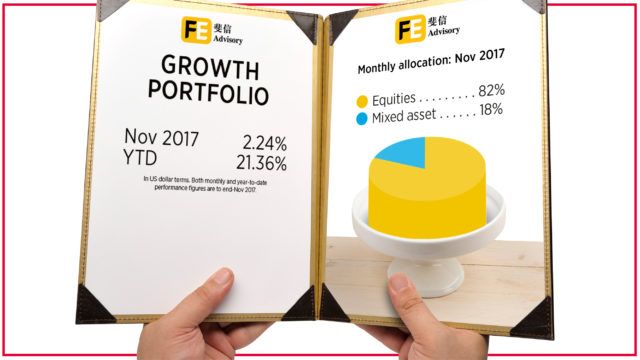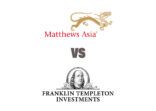Each month we feature the allocation in one of the three portfolios offered by FE Advisory Asia: cautious, balanced and growth. Data is included to show how well the portfolio has done compared to the previous month and year-to-date so that readers can get a sense of performance.
Additionally, Luke Ng, senior VP of research at FE Advisory Asia, provides a concise analysis on macro events and their potential impact on the portfolio.
A breakdown of the Growth portfolio at the end of October 2017. Performance figures are in the menu image above.

Portfolio breakdown and holdings are based on latest published data for each constituent, which may have publication dates that differ.
Percentages are based on current holdings and should only be used as a guide. Some information is provided to FE from independent third parties whom FE does not control. FE cannot guarantee the accuracy or reliability of the data, or its suitability for use by all investors.

How did the market perform in November?
Global equities continued to trend higher in November, with developed markets posting stronger returns than those in the emerging world. Japanese and US equities were the top performers among the major markets. The former was boosted by encouraging corporate earnings results, despite there being whipsaw within the month as economic data was a mixed bag. The latter on the other hand, benefited from the rising optimism over the approval of the tax reform initiated by the Trump administration. Relative to the developed market peers, European equities generally weakened as investors locked-in the profits they gained throughout the year. Still, they managed to stay in positive territory in US dollar terms as the euro strengthened over the month.
After the strong run throughout the year, emerging markets broadly traded sideways in November. Rising optimism over the US tax reform progress, as well as the potential of tighter global liquidity conditions weighed on sentiment in the emerging world. China posted better returns among its peers amid the internet giants extending their strong run in the year.
In fixed income, yield curves were somewhat flatter versus a month ago. November saw Jerome Powell being appointed as the next chairman of the US Fed, but that did not bring much uncertainty to the market as policy is not expected to differ significantly from its current path. Overall, government bond investors tended to be slightly better off than those invested into investment grade and high yield instruments.
How did the FE growth portfolio perform?
Our growth portfolio gained 2.24% in November, and 21.36% for the year-to-November in US dollar terms. It broadly traded in-line with the MSCI World, and outperformed that of the Bloomberg Barclays Global Aggregate Index in the month. Our position with JPMorgan Japan (Yen) benefited from the strong run in Japanese equities, and it significantly outperformed the market as well, thanks to the strong focus on quality growth stocks and the fund managers’ decision to use some gearing throughout the rising market. For our emerging market exposure, the holding in a China dividend focused strategy also proved beneficial amidst a stronger run in this respective market. Overall all funds within the growth portfolio posted positive returns in the month.
How did we rebalance the growth portfolio?
We have maintained our decision to slightly overweight the risk budget of our portfolio. After a strong run in Chinese equities over the last six months, we slightly reduced our exposure in China. However, it remained our favourite destination for equities due to the sound structural growth opportunities and reasonable valuations. We took the decision to exit from Schroder ISF Emerging Europe, and have replaced it with JPM Emerging Markets Equity to gain wider exposure in the emerging world. Instead of following a market-weighted approach to allocate our assets among developed market large-caps, we pursued a balanced approach to maintain similar weightings amongst the US, Europe and Japan. That means we underweight the US against mainstream global equity indices, as US equities are trading at high valuation versus peers as well as their own historical levels.
While volatility of the equity markets approached a decade low, we have managed to increase our equity exposure without increasing the risk budget of our portfolio. We have taken the decision to replace the Fidelity US Dollar Bond with a US small cap strategy. Earnings growth prospects for the sector in 2018 are expected to be solid, and could provide a bonus should the corporate tax reform be pushed through by US president Donald Trump’s administration. On the other hand, some fixed income exposure was maintained in the portfolio by holding a mixed asset fund that primarily invests into the US.
Asset breakdown & changes

FE Advisory Asia 2017 portfolio results
| Jan | Feb | Mar | Apr | May | Jun | First half of 2017 | |
| Cautious | 0.78% | 1.28% | 0.77% | 0.71% | 1.05% | 0.44% | 5.15% |
| Balanced | 2.03% | 0.78% | 0.19% | 1.23% | 1.85% | 0.44% | 6.69% |
| Growth | 2.57% | 2.00% | 0.53% | 1.19% | 2.81% | 0.17% | 9.61% |
| Jul | Aug | Sep | Oct | Nov | 2017 YTD | |
| Cautious | 0.68% | 1.16% | 0.34% | 1.64% | 0.63% | 9.90% |
| Balanced | 1.11% | 1.40% | 1.29% | 2.42% | 1.33% | 14.99% |
| Growth | 2.01% | 1.69% | 1.87% | 2.48% | 2.24% | 21.36% |
















